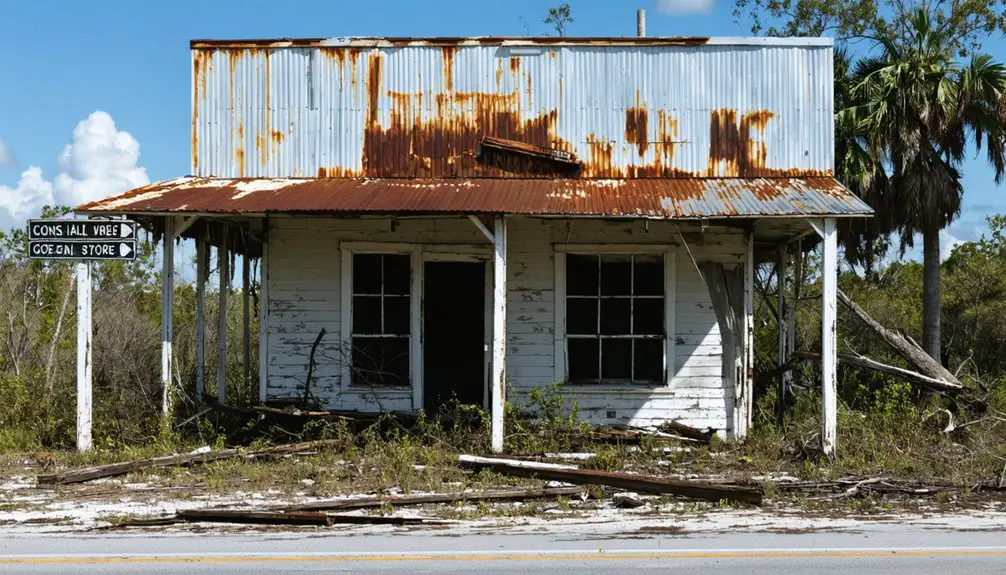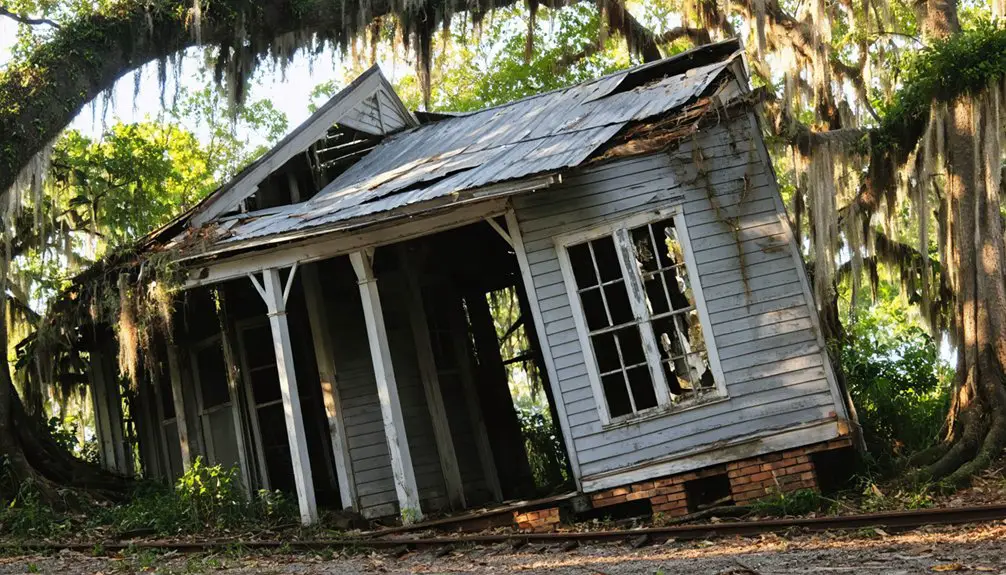You’ll find Ridgewood nestled in Polk County’s Bone Valley, where Davison Chemical Company established this phosphate mining town in the early 1900s. The settlement housed around 200 residents, with company-built homes, commissaries, and essential services creating a self-contained community. By the 1950s, mining expansion and economic hardship led to Ridgewood’s abandonment. Today, crumbling foundations and weathered brickwork peek through dense subtropical vegetation, each ruins telling a unique story of Florida’s industrial past.
Key Takeaways
- Ridgewood was a company town established by Davison Chemical Company during Florida’s phosphate boom in the early 20th century.
- Located between Mulberry and Bartow in Polk County, the town housed approximately 200 residents working in phosphate mining operations.
- The town featured company-built homes, basic utilities, and separate residential areas for white and African-American phosphate workers.
- Ridgewood declined during the Great Depression, with housing disappearing by the early 1950s as mining operations expanded.
- Today, only ruins remain, including crumbling foundations and weathered brickwork, hidden within dense subtropical vegetation.
The Birth of a Company Town
As Florida’s phosphate industry boomed in the early 20th century, Davison Chemical Company established Ridgewood as a purpose-built town along State Road 60 between Mulberry and Bartow.
You’ll find Ridgewood’s origins rooted in the region’s rich phosphate mining heritage, where it joined other company towns like Brewster, Nichols, and Pierce in housing crucial workers and their families. Workers enjoyed modern amenities and services provided by the company.
Located in Polk County’s Bone Valley, Ridgewood emerged during a peak period of company town development that stretched from the 1900s through the 1920s. The area’s phosphate was transported via narrow gauge railroads that connected mining operations to main rail lines.
The strategic location east of Bonnie Mine Road made it ideal for supporting Davison’s mining operations.
At its height, this modest but essential community housed around 200 residents, creating a self-contained world where workers could live near the mines that drove Florida’s phosphate boom.
Daily Life in Early Ridgewood
If you’d lived in early Ridgewood, you would’ve called one of the company-built family homes your residence, with your daily routine centered around shifts at Davison Chemical’s phosphate operations.
Your work life would’ve involved mining or processing phosphate at the factory, which employed most of the town’s 200 residents.
Like Brewster’s mining town, Ridgewood maintained separate residential areas for white and African-American workers during its operational years.
The town relied heavily on rail transport to move materials and supplies in and out of the area.
During off-hours, you would’ve joined your neighbors for informal gatherings in shared outdoor spaces, fostering the tight-knit social bonds typical of small company towns in early 20th-century Florida.
Housing and Home Life
The modest company-owned houses of Ridgewood provided shelter for nearly 200 phosphate mine workers and their families during the town’s peak.
You’d find these uniform dwellings strategically positioned near the mines and factory, reflecting typical housing standards of early 20th-century company towns. Family dynamics revolved around the demanding schedules of phosphate operations, with homes serving as gathering places for multiple generations under one roof.
Your daily comfort would’ve depended on basic company-provided utilities like water and electricity. The houses, while utilitarian in design, offered protection from Florida’s hot summers and mild winters. The town was built by Davison Chemical Company to ensure workers lived close to their jobs. Similar to the historic grand mansion ruins in Ellaville, these structures stood as testament to Florida’s industrial past.
You wouldn’t have owned your home – it came with your job at Davison Chemical. By the early 1950s, these houses disappeared entirely as mining operations expanded.
Work at Chemical Plant
Daily life at Ridgewood’s chemical plant mirrored the demanding rhythms of early 20th-century industrial work.
You’d start your shift handling phosphate ore in the washing and drying facilities, where chemical safety protocols were minimal by today’s standards. The company’s strict control extended beyond your work hours – they’d inspect your company-owned home and expected complete compliance with their rules.
Your daily routine revolved around the railroad schedules of the Atlantic Coast Line and Seaboard Air Line, as you processed materials for shipment.
Labor rights weren’t a priority – you’d work extended hours during peak seasons, managing heavy machinery and chemical processes.
If you left your job or retired, you’d lose your housing, making the workforce particularly vulnerable to company demands in this isolated industrial community.
Community Gathering Spots
Living in Ridgewood’s centrally clustered company housing meant you’d find most of your social interactions happening right in your neighborhood.
With about 200 residents living in close proximity, you’d naturally form bonds with your fellow phosphate workers and their families during daily routines.
The local general store served as your main gathering spot, where you’d catch up on news while picking up essentials.
Without formal meeting halls or churches, you’d make the most of shared outdoor spaces for community interactions.
Social gatherings often took place informally – maybe a community picnic on work breaks or children playing in the natural areas around town.
The town’s compact layout, centered around the phosphate plant, meant you’d spend most of your free time close to home, strengthening ties with your neighbors.
Some residents engaged in brick making activities, contributing to Florida’s industrial heritage during their time in Ridgewood.
With the nearest town half a mile away, residents relied heavily on their immediate community for social connection and support.
Industrial Legacy of Davison Chemical
You’ll find Davison Chemical’s industrial footprint prominently displayed through their pioneering sulfuric acid and phosphate fertilizer operations in early Ridgewood.
The company’s extensive chemical manufacturing complex treated raw phosphate rock with sulfuric acid to produce superphosphate fertilizers, establishing itself as a major player in Florida’s phosphate industry. Drawing on their heritage as America’s first sulfuric acid producer in 1832, Davison Chemical brought significant expertise to their Florida operations. The facility continued operating until Grace acquired Davison in 1954, marking a significant shift in ownership.
Around these industrial operations, Davison Chemical developed worker housing and basic infrastructure that formed the foundation of Ridgewood’s company town structure.
Chemical Production Operations
A pioneering force in chemical manufacturing, Davison Chemical Company established significant operations in Ridgewood, Florida, building upon its expertise in sulfuric acid production that dated back to 1832.
You’ll find their early focus centered on creating superphosphate fertilizers by processing ground bones and oyster shells with sulfuric acid.
Workforce Housing Development
During Davison Chemical’s expansion in Florida, the company established Ridgewood as a purpose-built town to house its growing workforce near the phosphate operations.
You’ll find this development reflected broader industrial trends, where chemical companies created self-contained communities to maintain a stable labor supply in Polk County’s phosphate region.
The workforce demographics centered on phosphate miners and processors, with housing evolution tracking the industry’s changes.
You’d have seen modest homes, commissaries, and community services that formed the backbone of daily life.
By the mid-20th century, shifts in labor relations transformed these arrangements. Workers began purchasing their company-built homes as union contracts reshaped employment terms.
Eventually, families left Ridgewood for urban areas, marking the end of this unique chapter in Florida’s industrial history.
Environmental Challenges and Natural Disasters

While many Florida ghost towns succumbed to economic decline, Ridgewood’s abandonment was intensified by the region’s unforgiving environmental challenges.
You’ll find evidence of nature’s relentless assault in the remains of this settlement, where high humidity and sea air rapidly corroded structures while dense vegetation reclaimed the land. The hot summers and seasonal weather fluctuations wreaked havoc on buildings, making disaster preparedness a constant concern.
Environmental degradation took many forms – from toxic algae blooms contaminating nearby waters to dangerous wildlife like rattlesnakes establishing territory.
The saw palmettos, scrub pines, and mangroves created an impenetrable barrier against redevelopment, while mosquitoes and other pests made daily life increasingly unbearable.
Periodic hurricanes delivered the final blows, destroying what remained of human habitation.
The Great Depression’s Impact
The Great Depression struck Ridgewood with devastating force, transforming this once-thriving Florida community into an economic wasteland.
Like many Florida towns, Ridgewood’s economic hardship was intensified by the perfect storm of:
- A devastating Mediterranean fruit fly infestation that destroyed 60% of local citrus production
- State-enforced quarantines that choked off crucial agricultural markets
- A catastrophic drop in tourism from 3 million to 1 million yearly visitors
Despite attempts at community resilience, you’d have witnessed widespread unemployment as nearly 25% of locals relied on federal relief aid.
The state constitution’s prohibition on deficit spending meant you couldn’t count on local government help.
With bank failures claiming personal savings and agriculture in ruins, many residents were forced to abandon Ridgewood in search of opportunity elsewhere.
Remnants and Ruins Today

Among crumbling foundations and weathered brickwork, modern-day Ridgewood stands as a haunting reminder to Florida’s boom-and-bust past.
You’ll find the site’s ruins scattered throughout dense subtropical vegetation, where palms and vines slowly reclaim what’s left of the town’s structural heritage. If you’re interested in ruins exploration, you’ll need to navigate carefully through undeveloped trails, watching for unstable ground and exposed metal hazards.
The most prominent features you’ll encounter are old brick chimneys and deteriorating wall segments, evidences of Ridgewood’s once-thriving brick industry.
While artifact preservation remains a concern, you might spot fragments of pottery, rusted tools, or household items emerging from the soil. The site’s minimal security and lack of formal archaeological protection mean you’re witnessing history gradually fading into Florida’s wilderness.
Historical Significance in Florida’s Industrial Era
Founded in the early 1900s by Davison Chemical Company, Ridgewood emerged as a significant phosphate mining settlement during Florida’s industrial evolution.
You’ll find this company town exemplified the economic shifts sweeping through rural Florida, as agricultural communities gave way to industrial operations.
The town’s significance in Florida’s industrial development is reflected in:
- Its role as a model of labor relations, where companies provided complete community infrastructure to maintain a stable workforce.
- Its contribution to Polk County’s dominance in phosphate production, helping establish Florida’s industrial mining sector.
- Its demonstration of corporate influence on community development, as Davison Chemical shaped every aspect of residents’ lives.
Ridgewood’s story captures an essential chapter in Florida’s evolution from rural backwater to industrial powerhouse, highlighting the complex relationship between companies and their workers.
Frequently Asked Questions
Are There Any Ghost Hunting or Paranormal Activities Reported in Ridgewood?
You won’t find documented ghost sightings or organized paranormal investigations here. While it’s a recognized ghost town, there’s no credible evidence of supernatural activity in the abandoned structures and surroundings.
What Happened to the Residents Who Left Ridgewood After Its Abandonment?
Like scattered seeds, you’ll find Ridgewood’s residents transplanted themselves to nearby towns including Mulberry and Bartow, seeking phosphate mining work, agricultural jobs, or service positions to rebuild their disrupted lives in 1950s Florida.
Can Visitors Legally Explore the Ghost Town Site Today?
You can’t legally explore the site due to strict exploration regulations and visitor safety concerns. It’s within active phosphate mining operations on private property where trespassing is prohibited.
What Specific Chemicals Were Produced at the Davison Chemical Facility?
You’ll find that Davison’s main chemical production focused on fluid cracking catalysts, SYLOID® silica products for coatings, and packaging chemicals, though specific details about this facility’s historical significance remain limited.
Are There Any Surviving Photographs of Ridgewood During Its Peak Years?
You won’t find publicly available photographs from Ridgewood’s peak years, despite its historical significance. Current archives and collections haven’t preserved definitive photographic evidence from this vanished Florida community.
References
- https://freepages.history.rootsweb.com/~gtusa/usa/fl.htm
- https://www.youtube.com/watch?v=jt6u3q3c2D4
- https://www.tiktok.com/@beyondflorida/video/7374885954487635246
- https://ghosttownadventures.wordpress.com/2024/07/07/ridgewood/
- https://www.ghosttowns.com/states/fl/ridgewood.html
- https://en.wikipedia.org/wiki/Bone_Valley
- https://fipr.floridapoly.edu/about-us/phosphate-primer/company-towns.php
- https://storymaps.arcgis.com/stories/fe053b4ac9a74a87be0c383c86f72834
- https://fipr.floridapoly.edu/about-us/phosphate-primer/timeline-of-phosphate-communities.php
- https://www.youtube.com/watch?v=Lv9sIPn3NgU



